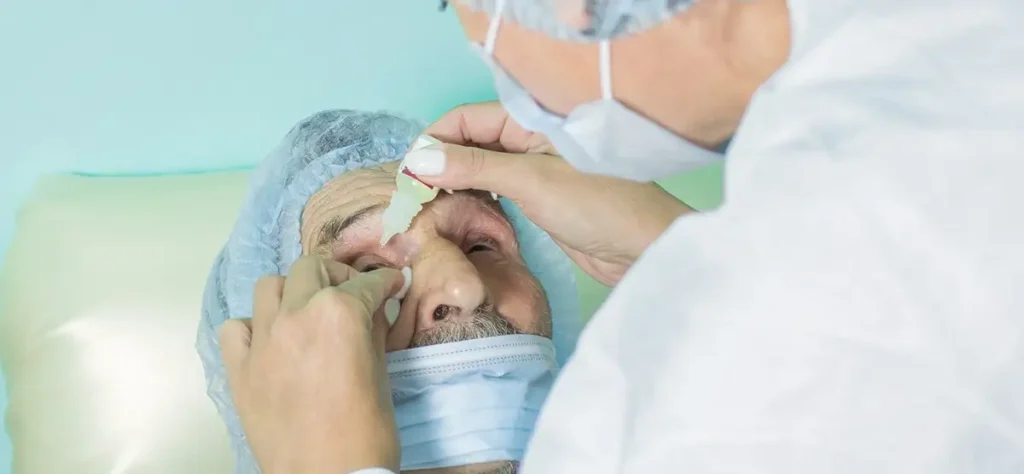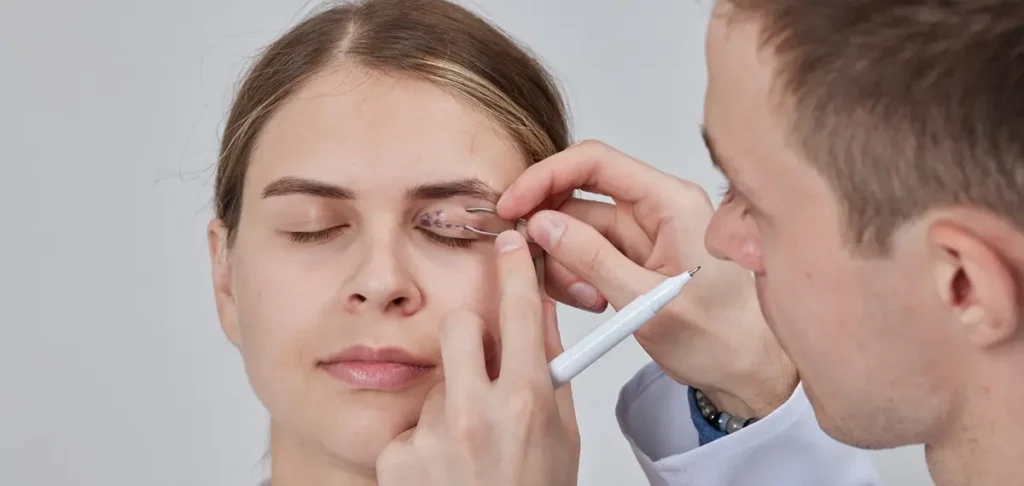Opening Hours
Mon - Thu: 10am – 6pmFri : 10am – 5pm
Sat : 10am – 4pm
The eyes are often considered the windows to the soul, and they’re certainly one of the first features people notice about your face. As we age, the delicate skin around our eyes shows some of the earliest and most prominent signs of time’s passage. Upper and lower eyelid surgery, collectively known as blepharoplasty, offers effective solutions to rejuvenate the eye area and restore a more youthful, refreshed appearance.
However, upper and lower eyelid surgeries are distinctly different procedures that address different concerns, involve varying techniques, and have unique recovery profiles. Understanding these key differences is essential for making informed decisions about which procedure, or combination of procedures, might be right for you.
Before exploring the differences between upper and lower eyelid surgery, it’s important to understand how the eye area ages and what specific problems each procedure addresses.
The periorbital region (area around the eyes) consists of some of the thinnest skin on the human body, making it particularly susceptible to signs of ageing. The muscles, fat pads, and supporting structures in this area also change over time, contributing to various aesthetic and sometimes functional concerns.
Upper eyelid ageing typically manifests as excess skin that may droop over the eyelash line, creating a hooded appearance that can make eyes look smaller, tired, or aged. In severe cases, this excess skin can actually impair vision by obstructing the upper visual field.
Lower eyelid ageing commonly presents as under-eye bags caused by protruding fat pads, fine lines and wrinkles, loose skin, and sometimes a hollowed appearance that creates dark circles or shadowing under the eyes.
What Upper Blepharoplasty Treats
Upper eyelid surgery specifically addresses concerns affecting the upper portion of the eye area:
Excess upper eyelid skin that creates a hooded or heavy appearance, making eyes appear smaller or more tired than they actually are.
Drooping eyelid skin that may hang over the eyelash line and, in severe cases, obstruct vision or interfere with activities like reading or driving.
Fat pad protrusion in the upper eyelid area that creates bulging or asymmetry.
Deep upper eyelid creases that have become more pronounced with age or contribute to a tired appearance.
Functional impairment where excess skin actually interferes with vision, making this sometimes a medically necessary procedure rather than purely cosmetic.
Upper eyelid surgery is typically performed as an outpatient procedure under local anaesthesia with sedation, though general anaesthesia may be used in some cases.
Incision placement is carefully planned within the natural crease of the upper eyelid, ensuring that any resulting scar will be well-hidden when the eye is open. This natural camouflage is one of the significant advantages of upper eyelid surgery.
Tissue removal involves the precise excision of excess skin and sometimes underlying muscle or fat. The amount removed is carefully calculated to achieve the desired result while maintaining natural eye function and appearance.
Closure technique uses fine sutures to bring the incision edges together with minimal tension, promoting optimal healing and scar formation.
The entire procedure typically takes 1-2 hours for both eyes, making it one of the more straightforward cosmetic surgical procedures.
Recovery from upper eyelid surgery is generally more straightforward than lower eyelid procedures:
Immediate post-operative period involves some swelling and bruising, which typically peaks within 48-72 hours and then gradually subsides.
Suture removal usually occurs 5-7 days after surgery, at which point most patients can return to work and normal activities.
Activity restrictions are minimal, though patients should avoid heavy lifting, strenuous exercise, and activities that significantly increase blood pressure for about two weeks.
Final results become apparent within 4-6 weeks as swelling completely resolves and incision lines mature.

Upper eyelid surgery typically provides:
What Lower Blepharoplasty Treats
Lower eyelid surgery addresses different concerns specific to the under-eye area:
Under-eye bags caused by protruding or repositioned fat pads that create a puffy, tired appearance.
Loose lower eyelid skin that may create fine lines, wrinkles, or a crepey texture.
Tear trough deformity where there’s a visible groove between the lower eyelid and cheek, creating shadows and an aged appearance.
Lower eyelid laxity where the eyelid itself has lost structural support and may appear to droop or pull away from the eye.
Combination of volume loss and excess where some areas appear hollow whilst others are puffy, creating an uneven under-eye contour.
Lower eyelid surgery is more complex than upper eyelid surgery due to the intricate anatomy and multiple tissues involved:
Approach options include transconjunctival (from inside the eyelid) or external (through a skin incision). The choice depends on your specific anatomy and the corrections needed.
Transconjunctival approach is used when the primary concern is fat repositioning or removal without significant skin excess. The incision is made inside the lower eyelid, leaving no visible scar.
External approach is necessary when excess skin must be removed or when more extensive rejuvenation is required. The incision is typically made just below the eyelash line.
Fat management may involve removal, repositioning, or both. Modern techniques often focus on repositioning fat rather than simply removing it, creating more natural, long-lasting results.
Additional procedures such as canthopexy (tightening of the lower eyelid support) or skin resurfacing may be performed simultaneously to optimise results.
Lower eyelid surgery typically involves a more complex recovery process:
Initial healing period involves more significant swelling and bruising that may take 1-2 weeks to substantially improve.
Activity restrictions are more extensive, with patients needing to avoid bending over, heavy lifting, and strenuous activities for 2-3 weeks.
Suture removal occurs at varying timeframes depending on the techniques used, typically 5-10 days post-surgery.
Temporary side effects may include increased tear production, dry eyes, or temporary changes in lower eyelid position that usually resolve with healing.
Complete recovery and final results may take 3-6 months as tissues fully settle and any swelling completely resolves.
Expected Outcomes
Lower eyelid surgery typically provides:
Complexity and Duration
Upper eyelid surgery is generally more straightforward, taking 1-2 hours with relatively predictable outcomes and fewer potential complications.
Lower eyelid surgery is more complex, potentially taking 2-3 hours and requiring greater surgical expertise due to the intricate anatomy and multiple tissue layers involved.
Scarring and Healing
Upper blepharoplasty scars heal within the natural eyelid crease, making them virtually invisible once healed. The healing process is typically uncomplicated.
Lower blepharoplasty scars vary depending on approach. Transconjunctival approaches leave no visible scars, whilst external approaches create scars just below the lash line that, whilst well-concealed, require more careful healing management.
Recovery Timeline
Upper eyelid recovery is generally faster, with most patients returning to normal activities within a week and seeing final results within 4-6 weeks.
Lower eyelid recovery takes longer, often requiring 2-3 weeks before returning to full activities and 3-6 months for complete results to be apparent.
Potential Complications
Upper blepharoplasty complications are relatively rare and may include infection, asymmetry, or overcorrection. Serious complications affecting vision are extremely uncommon.
Lower blepharoplasty complications can be more varied and include temporary or permanent changes in eyelid position, dry eyes, scarring issues, or asymmetry. These procedures require more specialised expertise to minimise risks.
Functional vs. Aesthetic Considerations
Upper eyelid surgery may address both functional concerns (vision impairment) and aesthetic goals, sometimes making it a medically necessary procedure.
Lower eyelid surgery is primarily aesthetic, focusing on appearance enhancement rather than functional improvement.

Many patients benefit from combining upper and lower eyelid surgery in a single procedure, often called a “four-lid blepharoplasty.” This comprehensive approach can provide:
Advantages of Combined Surgery
Comprehensive rejuvenation that addresses all eye area concerns simultaneously.
Balanced results ensuring that improvements to one area don’t make other areas appear more aged by comparison.
Single recovery period rather than two separate healing phases.
Cost efficiency as combined procedures are often more economical than staged surgeries.
Considerations for Combined Procedures
Extended surgery time and potentially increased anaesthesia requirements.
More intensive recovery with potentially more swelling and bruising initially.
Higher complexity requiring surgeons with expertise in both procedures.
Increased initial investment though potentially more cost-effective long-term.
Candidates for Upper Blepharoplasty
You may be an ideal candidate for upper eyelid surgery if you have:
Candidates for Lower Blepharoplasty
Lower eyelid surgery may be appropriate if you experience:
Age considerations – Both procedures can be performed on patients ranging from their 30s to 70s and beyond, depending on individual anatomy and goals.
Health status – Good general health is essential for any surgical procedure, with particular attention to eye health and any medications that might affect healing.
Lifestyle factors – Smoking significantly impairs healing and increases complication risks, particularly for eyelid surgery.
Realistic expectations – Understanding what each procedure can and cannot achieve is crucial for satisfaction with results.
Non-Surgical Options
For patients not ready for surgery or with mild concerns, non-surgical alternatives may provide some improvement:
Radiofrequency treatments can provide mild skin tightening for the eye area.
Injectable treatments such as dermal fillers can address tear trough concerns or volume loss.
Laser resurfacing may improve fine lines and skin texture around the eyes.
Botox injections can address dynamic wrinkles and may provide subtle brow elevation.
Both upper and lower blepharoplasty can be enhanced when combined with:
Durability of Results
Upper blepharoplasty results typically last 10-15 years or longer, as the excess skin that’s removed doesn’t regenerate.
Lower blepharoplasty outcomes can be long-lasting, though the under-eye area may continue to age gradually over time.
Factors Affecting Longevity
Genetics play a significant role in how quickly ageing continues after surgery.
Sun protection is crucial for maintaining results and preventing premature ageing of the delicate eye area.
Skincare regimen including quality moisturisers and retinoids can help maintain skin quality.
Lifestyle factors such as smoking, sleep quality, and overall health significantly impact long-term results.
Future Treatment Considerations
Revision procedures are occasionally necessary, more commonly with lower eyelid surgery than upper.
Complementary treatments may be beneficial years later to address continued ageing in adjacent areas.
Maintenance procedures such as injectable treatments or skin resurfacing may help extend and enhance surgical results.
Consultation Process
A comprehensive consultation should include:
Questions to Ask Your Surgeon
Experience and credentials – Ensure your surgeon is qualified and experienced in eyelid surgery.
Approach preferences – Understand why specific techniques are recommended for your case.
Risk management – Discuss how complications are prevented and managed if they occur.
Recovery support – Understand what support will be available during your healing process.
Upper and lower eyelid surgery offer powerful solutions for rejuvenating the eye area, but they address different concerns through distinct surgical approaches. Understanding these key differences helps ensure you make informed decisions about your aesthetic goals.
Upper blepharoplasty provides straightforward correction of drooping, excess upper eyelid skin with relatively simple recovery, whilst lower blepharoplasty offers more complex rejuvenation of the under-eye area with a more involved healing process.
The choice between these procedures, or the decision to combine them, should be based on your specific anatomy, concerns, lifestyle, and aesthetic goals. At Linia Cosmetic Surgery, our experienced team specialises in both procedures and can help you determine the most appropriate approach for achieving your desired results.
Whether you’re considering upper eyelid surgery, lower eyelid surgery, or a combination approach, the key to success lies in choosing qualified surgeons, having realistic expectations, and committing to proper pre- and post-operative care. The investment in eyelid rejuvenation can provide years of enhanced confidence and a more youthful, refreshed appearance that reflects how vibrant you feel inside.
Posted In: Face Treatments Blogs
Written By: Dr Azhar Aslam
The journey can be hard, but if you've been inspired by our patients, get in touch.
Book a Consultation Request a Brochure










Linia CS Limited, trading as Linia Cosmetic Surgery, is an Appointed Representative of Chrysalis Finance Limited, which is authorised and regulated by the Financial Conduct Authority.
* Every patient is a unique individual and every surgery has unique aspects. Therefore, results may vary. To read our full disclaimer please click here.
Website by Link Digital